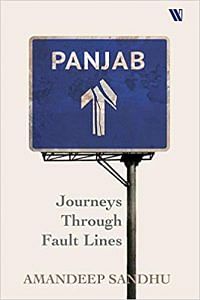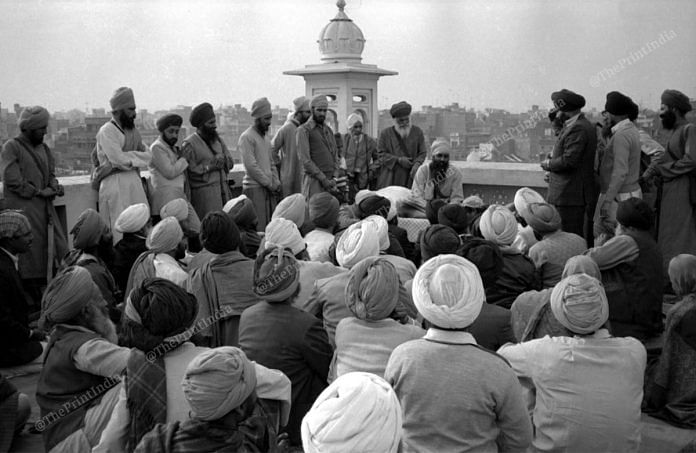‘Be ready to count the corpses,’ Satpal Danish had said. Throughout my travels in Panjab, talk and acknowledgement and the counting of corpses was a part of almost every conversation I had with people and the news I read on Panjab. In a state that had one-fifth of all the national arms licences, the gun was often not very far from most conversations. I could often make out the gun sticking out from the pyjama pocket or the holster of the person I was meeting. Upon my noticing the gun the person would give a sardonic smile. I would ask if the person had been part of the movement (Khalistan) and had killed someone. Many would admit to sympathy for the movement, or tell me they were part of it for a while, or they had even done jail for some months, and I was ever thankful no one said they had killed anyone, even if it were a lie. I do not know how I would have behaved with someone who had admitted to a killing.
Corpses also framed much of my travels. When I was looking at Dera Radhaswami Beas, a friend asked me to meet his father to learn how his father i.e. my friend’s grandfather, was killed. The son of a former Congressman, Ravinder Kalia from Rayya, told me how during the peak of violence, pretty much their entire small town would empty out into the dera for the night. ‘It started with small incidents and moved towards greater plunder. Those who didn’t have cycles suddenly owned motorcycles. In Rayya, there would be one or two gang-related kidnappings every year. The only place we all had to go for the nights was the dera.’ Indeed, there is no news of the dera having ever been under attack or even threatened by the militants.
Kalia then proceeded to relate the incident. ‘That day there was no warning. They landed up in the mandi. There must have been a thousand people there. They came on a motorcycle, pointed the gun to the back of my father’s head and shot him point blank. I was at the rice sheller. My brother was at our arthiya shop and he called me.’
When Kalia learnt of the news and rushed home, the father’s body was still in post-mortem. The telephone rang. The militant on the other end said coldly: ‘You are not allowed a public funeral.’
In the next day’s issue of the Ajit dated 14 January 1990, there was a news item that the militants took responsibility for the killing, saying my father was a Congressman and an anti-Khalistani.
‘When he was killed, my father was chairman of Markfed. My younger brother had been sarpanch for two decades. I had been an elected member of the municipality and its president. But after my father’s killing, the erosion started. People started leaving. Businesses stated moving out to other cities, Jalandhar, Amritsar, even Delhi and out of the state. In 1991, when the Census took place, we discovered that the population of the town had decreased.’
In spite of knowing the SSP and getting immediate police protection, the family could not cremate the body in the cremation ground. Under cover, late evening, the family had conducted the last rites in a corner of their rice sheller. ‘But we did not leave. I reckoned that we had spent all our lives here, where would we reach if we were to start all over again? Most of the families that moved suffered bad times.’
‘But how was life here?’ I asked, sad at the killing, sadder at the denial of cremation, but with admiration for the Kalia family standing its ground.
‘Threats started coming over the phone. Mostly about children. We sent away all the kids to boarding schools in Shimla. Most villagers came back to town but those who left town took a long time to recover. We went back by a quarter century. In those days the dera earned a good name.’
Also read: In wrong place at wrong time: Forgotten story of Operation Blue Star’s ‘Jodhpur detainees’
What Kalia told me was the regular critique of the militancy movement and its anti-Hindu and anti-Congress narrative. He added that in those days there was regular exchange of fire between militants and Hindu families, in many villages of Amritsar and Gurdaspur. Many families migrated, some came back later but some stayed away too. Yet, was that the complete story?
On my journey along Budda Dariya, after the Neelon Bridge, at Katani Kalan, I stopped for directions at a cloth store. The shop owner, Satish, sounded urban and I asked why he had his shop here, on a state highway when perhaps Ludhiana would be good for business. He told me he was from Ludhiana and travelled twenty-five kilometres a day to run his shop there as the city was too crowded. I was struck by this reverse migration for work and asked him since when he had been running the shop. He said for more than three decades.
This brought me to a sensitive question, but since he had offered me tea, I dared ask it. ‘But wasn’t it risky in those days?’ He understood the implication. He was a Hindu.
‘In fact, no. This was Rashpal Singh Chandra’s area.’
I was a bit taken aback. Not only because the name of the militant was also Baba’s name, but because Satish was agreeing that the militants had marked areas. ‘Rashpal never let us be looted like other khadkus (militants). He was very clear; people should not be affected.’ The saga of militancy is layered and entwined, but this was a very different version, from the most unlikely angle—a Hindu man talking good about a militant who had made life hell for law enforcement agencies for about eight years.
‘But it was a reign of fear, no?’
‘Not under Rashpal’s protection. One morning we saw two bodies of young men lying on the road, not far from here. Next to them was a note by Rashpal: the men were looting from ordinary people. This is the lesson to anyone who dares do that.’ He used the word sodha (rectification). ‘You know how people had spontaneously assembled to gather his body after the police tortured and killed him. They didn’t allow police to cremate him anonymously.’ From the early 1990s, I remembered people talking about him—legs torn apart, body with torture marks. I later checked with a few police officers from those days. Privately, they agreed.
‘Still, I was attacked. Two boys walked in one evening to demand ransom. One shutter was down, the smaller one was open. As I bent down to open my cash counter to pull out cash, I surprised the boy closer to me by grappling with him. You know, head on, like wrestlers. The gun in his hand went off. The bullet went through my chin; luckily it came out from my neck. Else it would have gone to the brain. See,’ he raised his chin for me to show his entire stitched-up jaw. ‘But I didn’t realise, I kept holding the boy.’
Then?’
‘I do not know what happened. I woke up in hospital eleven days later. It took me six months to recover.’
‘Why did you still come back?’
‘Because of Rashpal. When I came home from hospital his father came to see me. He took my assurance that I wouldn’t leave my business and would keep coming to the shop. I owe it to them.’
Rashpal Singh Chandra was an ordinary farmer who had turned to militancy to avenge Operation Blue Star. He was once picked up, but no policeman recognised him and he escaped. After this the police brutally tortured his father and the rest of the family. This strengthened his drive and he started targeting policemen and made life hell for them.
I checked with others too, enroute on my Budda Dariya adventures and never got a negative story about him from anyone.
Also read: How Tihar jailers protected Sikh inmates after Indira Gandhi’s assassination
That is why, as the shop owner said, upon his death through brutal police torture in June 1992, ordinary villagers gathered in thousands. They did not allow the police to secretly cremate his body. They conducted an honourable cremation themselves.
These two stories, placed next to each other, depict a complete contrast about what militants did, how they operated and what their goals were. This contradiction has lasted in Panjab since the days of militancy and now extends to support for or against Bhindranwale and the question of whether Khalistan was a worthy goal or not.
 This excerpt from Amandeep Sandhu’s book Panjab: Journeys through Fault Lines has been published with permission from Westland Publications.
This excerpt from Amandeep Sandhu’s book Panjab: Journeys through Fault Lines has been published with permission from Westland Publications.




hahaha..trying to humanize militants?
A Great Scoop by The Print, The book Sounds like a very good Read and Gives a Different Angle To The Punjab Militancy Decade Of Terror where putting aside canard/fake propaganda spread by persons inside/outside the state people did come across the human side of some gun toting militants and policemen/security forces and even some politicians who were active during the 1980s-early 1990s timeline.
Only Kale Kachay walae dacos frankensteins created by the then Indian Government indulged in loot and killing of Hindus in the guise of Sikhs thus giving Sikh independence movement implausibility among the masses. There is still general consensus among the common man of Punjab that the Punjab independence movement was for the benefit of common Punjabis who had been fooled by the Nehrus and Gandhis of India at the time of Partition of Punjab.
Stop lying
I m not going to blame game that who was responsible for this. May be congress could not assess that Jarnail singh became so powerful n such situation came after this
Militancy in Punjab is a phase of Independent History. Congress brought Bhindrawalan to defeat SAD but later Bhindrawalan was so powerful due to political shelter it made an integrated episode of Khalistan , Operation Blue star and militancy in Punjab in 80 n 90 .